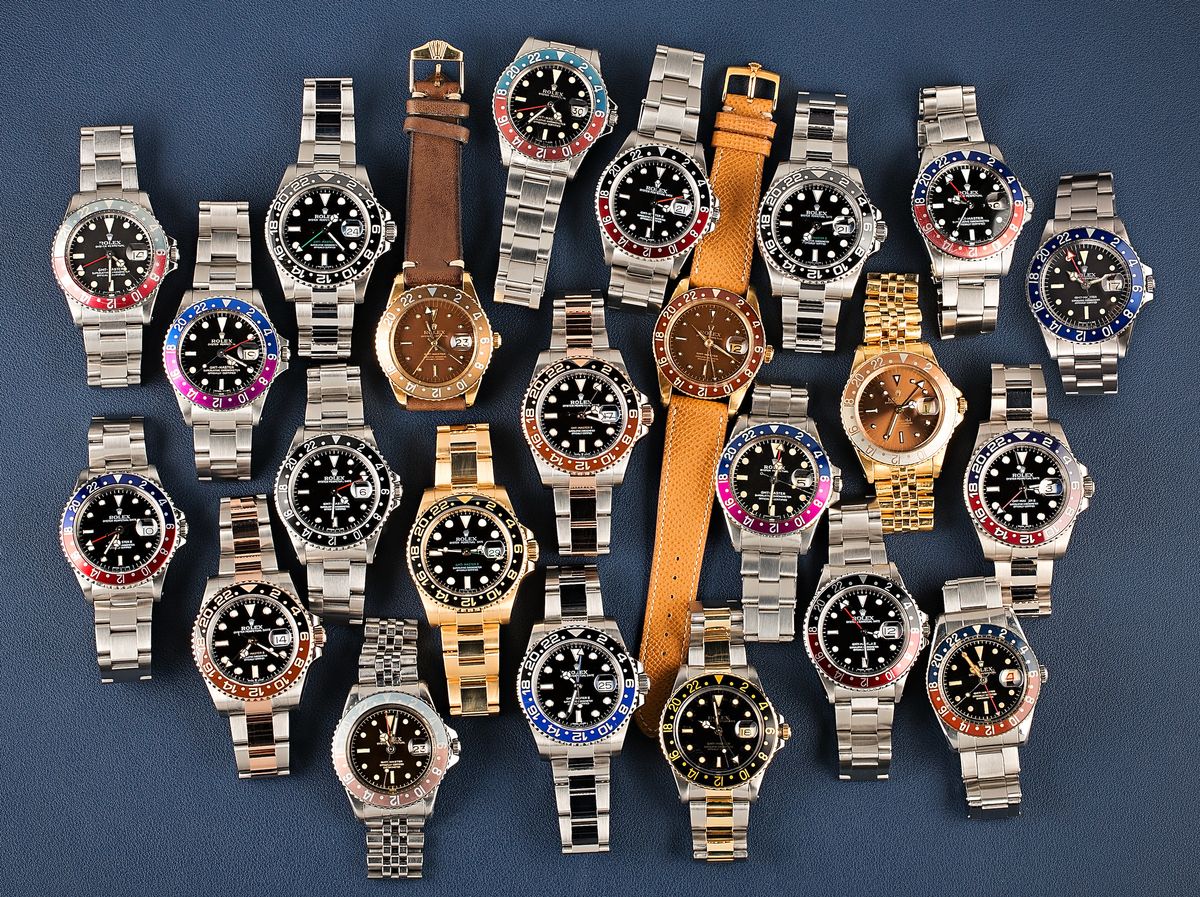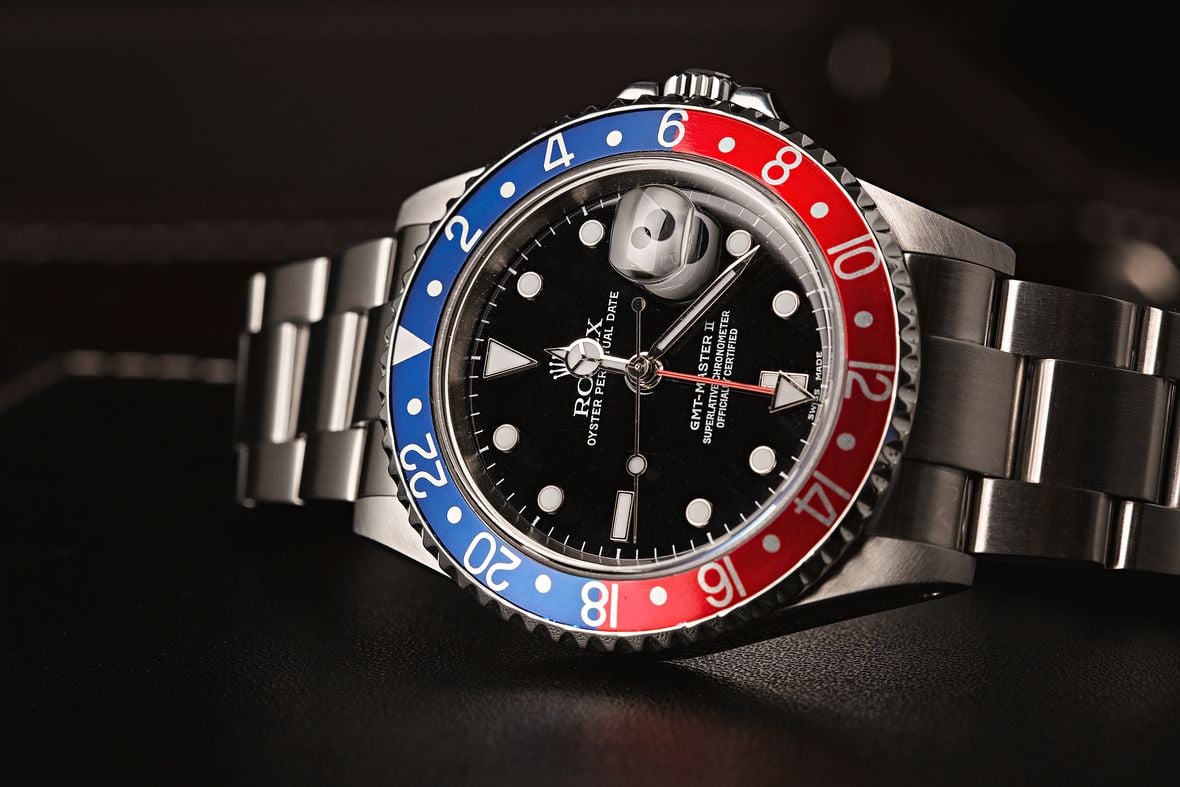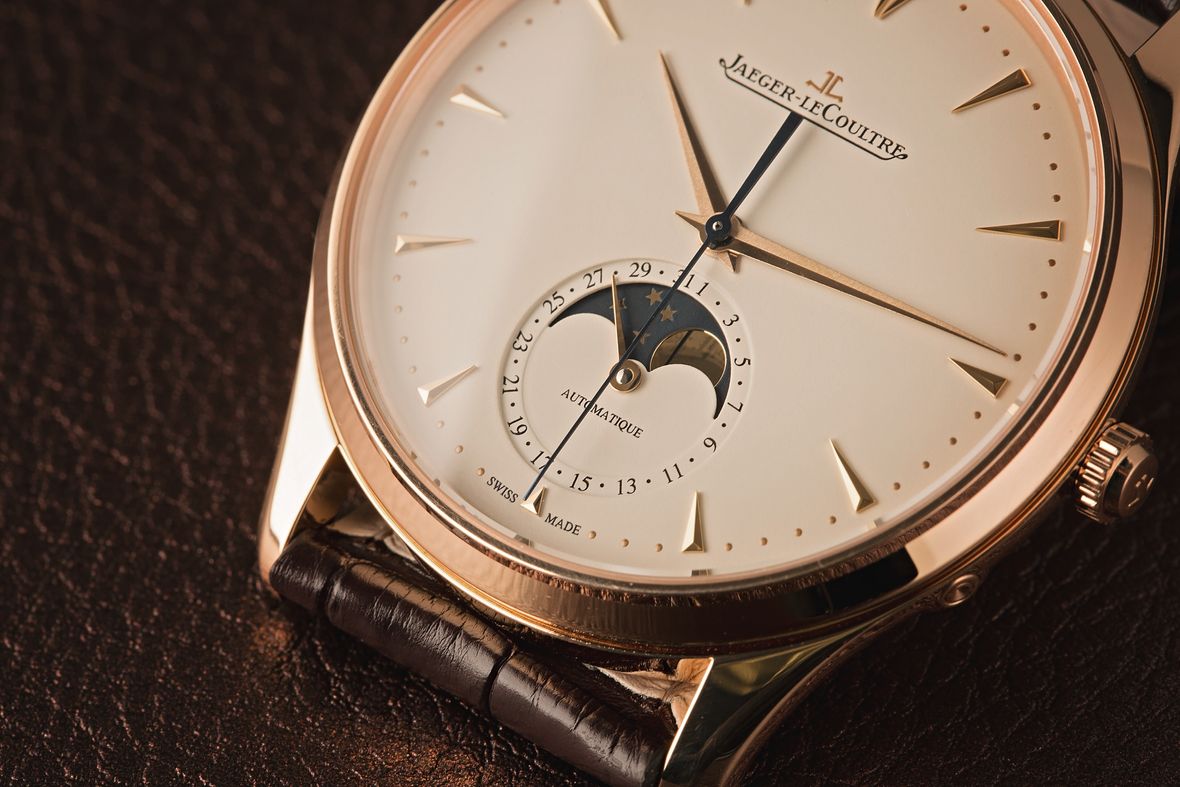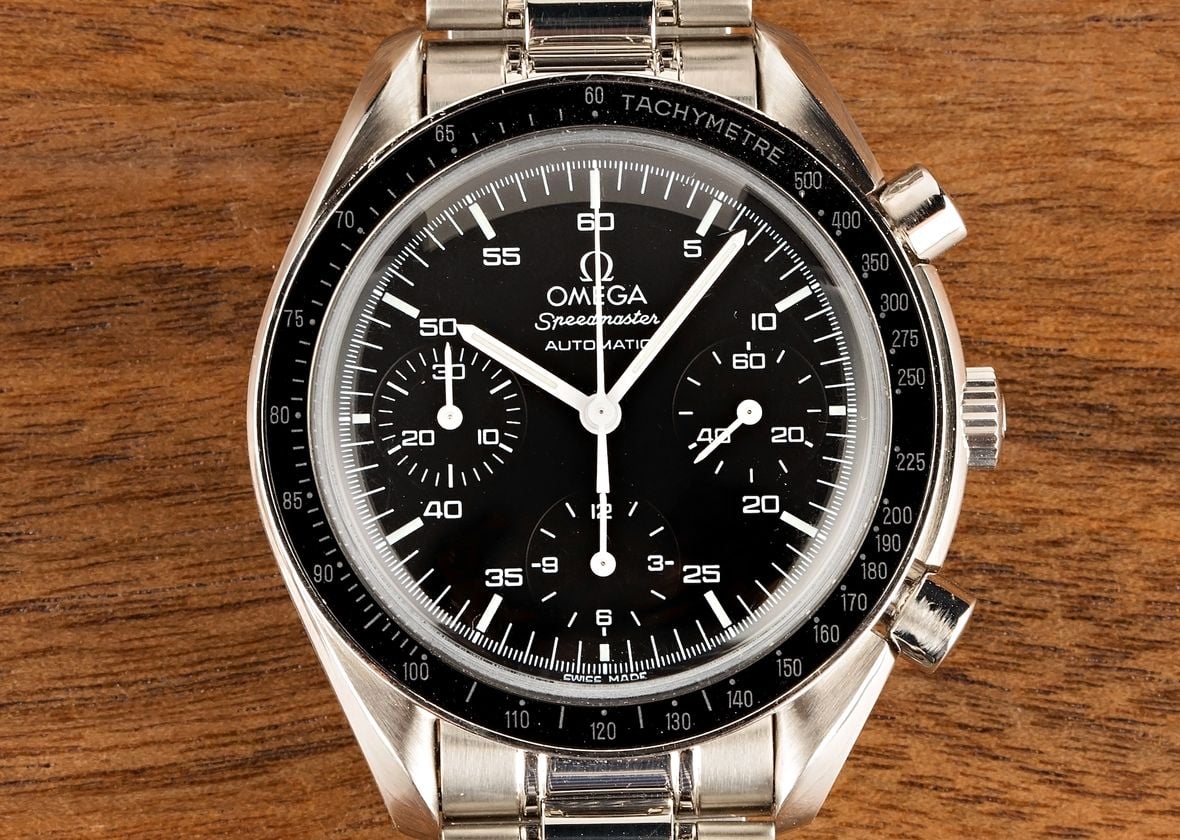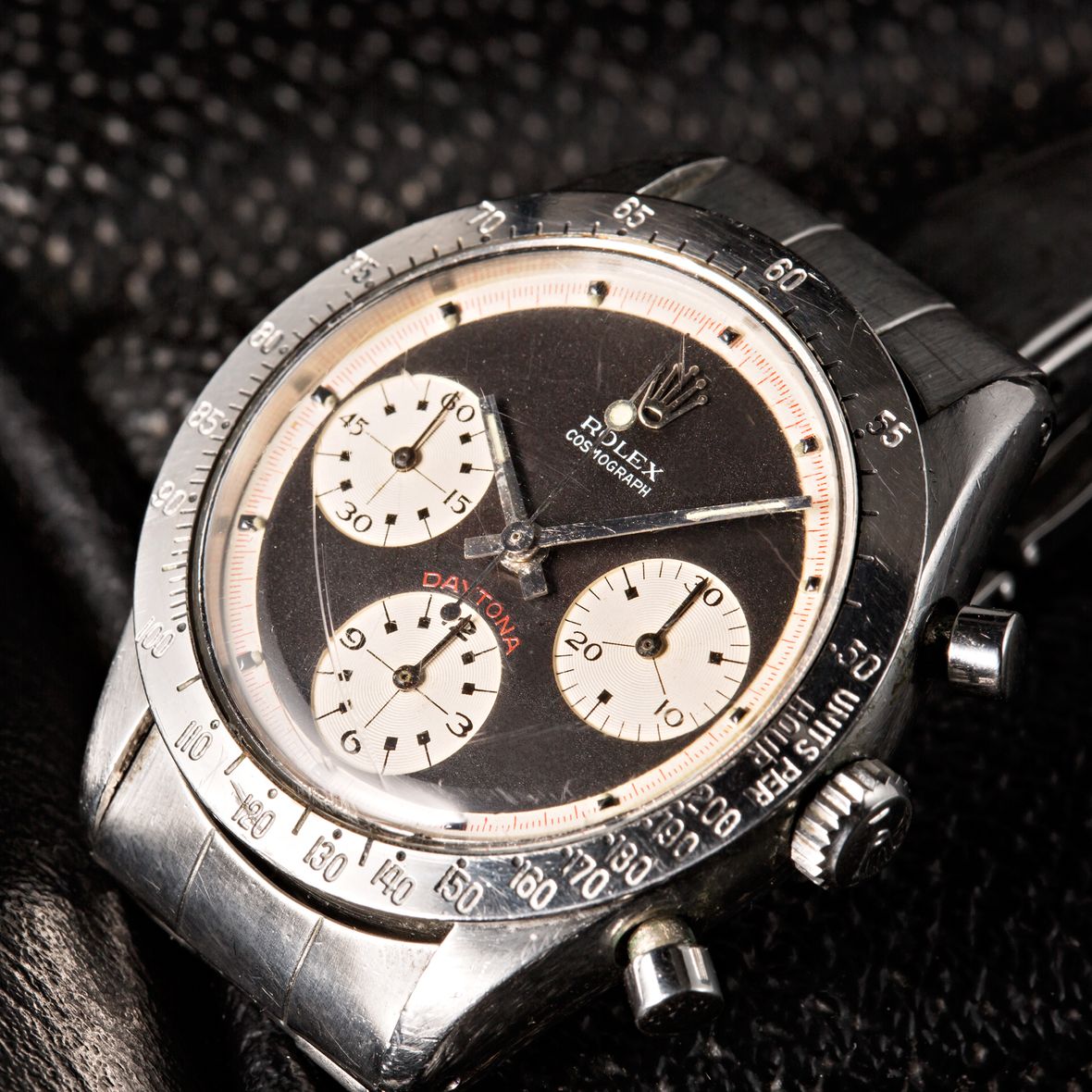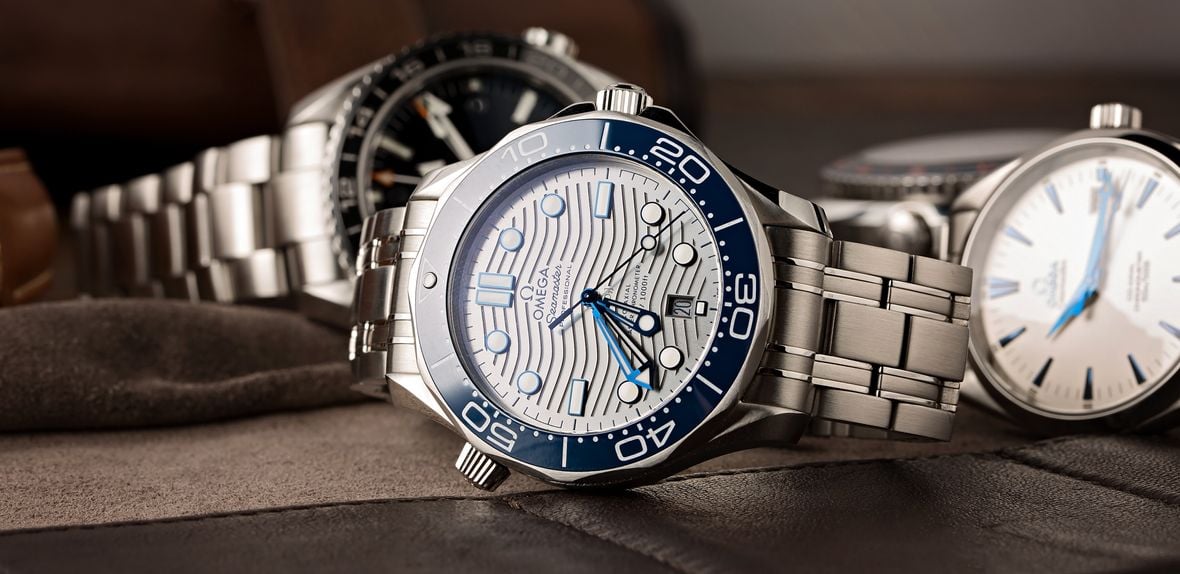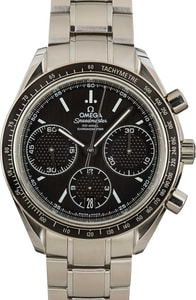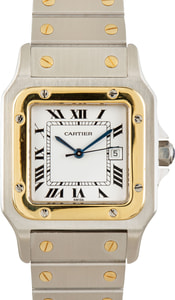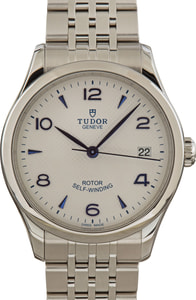The Rolex catalog consists of two categories: classic and professional. “Classic” refers to dress watches in a variety of design sets, while the “professional” collection includes tool watches geared towards various professions, such as doctors, pilots, and divers. The Rolex GMT is a pilot’s watch with dual-time capabilities. It is coveted by collectors from all walks of life and boasts an impressive selection of design sets and budgets.
Our ultimate Rolex GMT-Master buying guide will discuss everything related to the brand’s legendary GMT collection, including its history, price, features, options, and where you can buy it.
Rolex GMT-Master
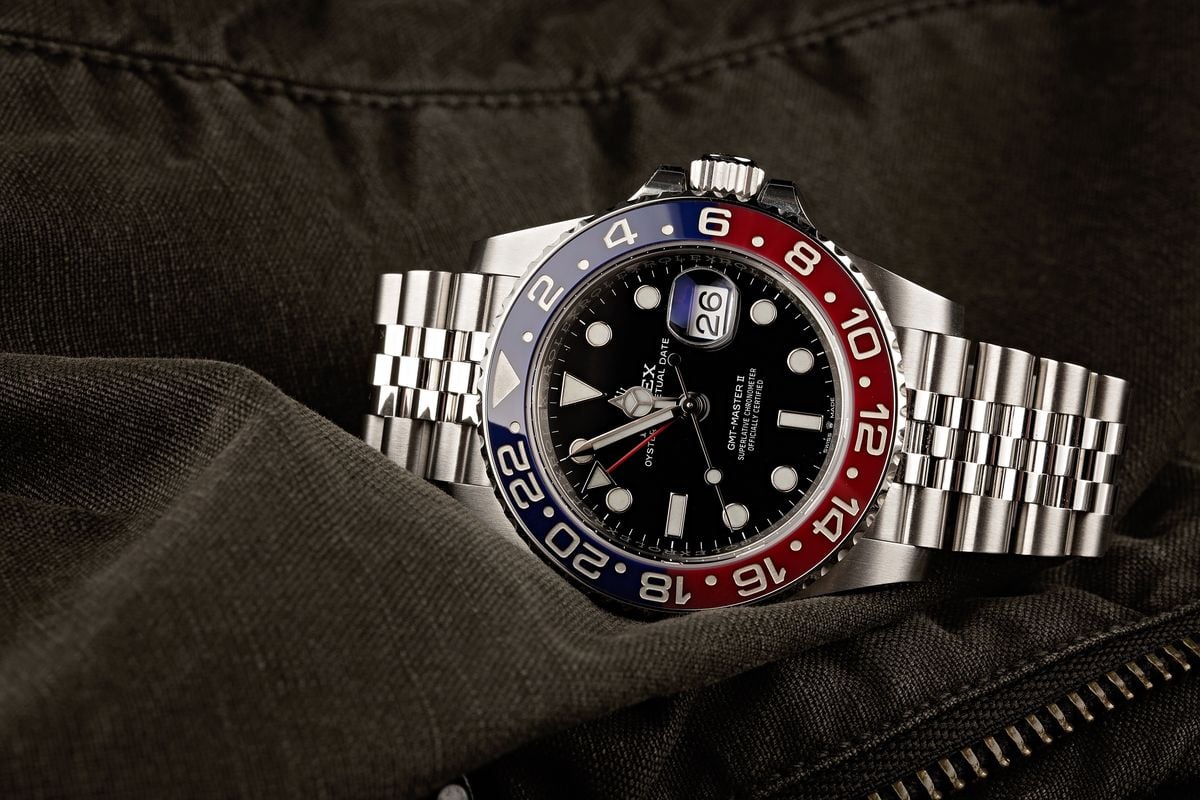
Rolex GMT-Master II Current Collection Key Features:
Case Diameter: 40mm
Materials: Stainless steel; Everose Rolesor; 18k Everose gold; 18k white gold
Features: Time + running seconds, date display, GMT functionality
Dial: Black; blue (white gold model only); meteorite (white gold model only)
Bezel: Bi-directional GMT bezel with bi-color Cerachrom insert
Movement: Rolex Caliber 3285
Water Resistance: 100 meters / 330 feet
Strap/Bracelet: Oyster bracelet (gold and two-tone models); Jubilee bracelet (stainless steel models)
Click here for a reference guide on the different bezels of the Rolex GMT-Master.
GMT-Master History
The 1950s saw the release of some of Rolex’s most iconic tool watches, including the Submariner diver’s watch, GMT-Master pilot’s watch, and Milgauss anti-magnetic watch. As the story goes, Pan Am requested a dual-time watch that their pilots and crews could use on long-haul flights, and the Rolex GMT-Master was born. While the watch, in its current form, is the epitome of modern luxury, its design remains largely the same as the original 1950s reference with a 24-hour bezel, a dedicated GMT hand on the dial, and a self-winding movement.
The first reference hit the market in 1955 in the form of the ref. 6542. It was outfitted with a Bakelite bezel (which Rolex later replaced with aluminum after just a few years) and an Oyster case with a 50-meter depth rating. During its 5-year production run, three movements powered the ref. 6542: caliber 1036, 1065, and 1066. Rolex added crown guards in 1959 and increased the case size to 40mm with the reference 1675, which was also the first instance of a COSC-rated movement within the series.
The ref. 16750 followed in 1981, bringing with it the caliber 3075 with a Quickset function. For the first time within the GMT-Master collection, the date mechanism could be changed without rotating the crown a full 24 hours. The ref. 16700 rounds out the original GMT-Master series in 1988, which would ultimately be replaced by the current GMT-Master II (although the two models were offered alongside each other for a short time). As a somewhat modern wristwatch, the ref. 16700 holds the distinction of being the only GMT-Master to feature a sapphire crystal. On the wrist, it was noticeably more contemporary than its predecessors but was ultimately discontinued in favor of the GMT-Master II.
Learn more by reading our Rolex GMT-Master history article.
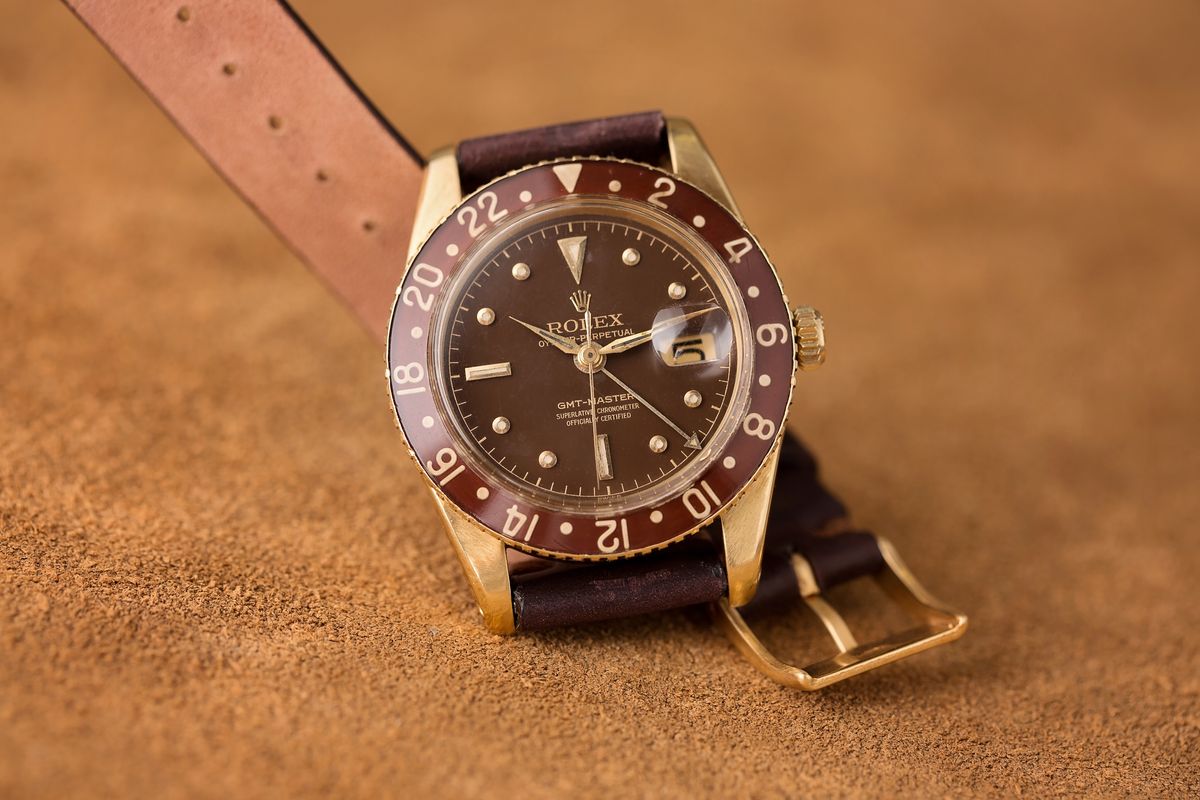
The GMT-Master II
Rolex introduced the GMT-Master II in 1982. For the first time, the GMT hand became independent from the standard, 12-hour hand. This added function initially required a fatter case, earning the first reference within the GMT-Master II 16760, the nicknames “Fat Lady” and “Sophia Loren” among the collecting community. In true Rolex fashion, the case and movement were refined under the next reference produced, 16710. Its sleeker profile and newly-independent 24-hour hand made the 16710 Rolex a huge success, and it remained on the market for nearly 20 years, from the late 1980s until around 2007.
The mid-2000s marked the transition into the contemporary GMT-Master II as we know it today. The 6-digit series ref. 1167xx received an upgrade from the Twinlock screw-down crown to the Triplock screw-down crown. Additionally, the bezel received a tougher Cerachrom ceramic insert and a new mounting system that operates on 24 clicks instead of 120. The new case dubbed the “Super Case” by many Rolex aficionados, wears a bit larger than its predecessors with larger crown guards, thicker lugs, and bigger Maxi hands and hour markers. Coupled with the polished center links down the middle of the Oyster bracelet, the upgrades given to the 6-digit series lend themselves to an irresistibly contemporary pilot’s watch that isn’t too flashy and keeps its timeless charm.
The ref. 116710BLNR was released during this time and was the first Rolex to feature a black and blue ceramic bezel insert. The ref. 116710BLNR was produced on a flat-link Oyster bracelet and has since been discontinued and replaced with the current Jubilee bracelet edition ref. 126710BLRO.
That brings us to the final stop in our brief GMT-Master history, the 1267xx series. The Cal. 3186 movement that powered the ref. 1167xx generation was replaced by the caliber 3285. For the first time within the series, the ceramic Pepsi bezel is available in stainless steel under ref. 126710BLRO. The last instance of the Pepsi GMT-Master II in stainless steel was the ref. 16710, which had an aluminum bezel insert. Additionally, the Batman GMT-Master II with a blue and black ceramic insert is available for the first time on the 5-link Jubilee bracelet under ref. 126710BLNR. The lume present on the dial is long-lasting blue Chromalight, and the series is now equipped with Rolex’s proprietary Chronergy escapement.
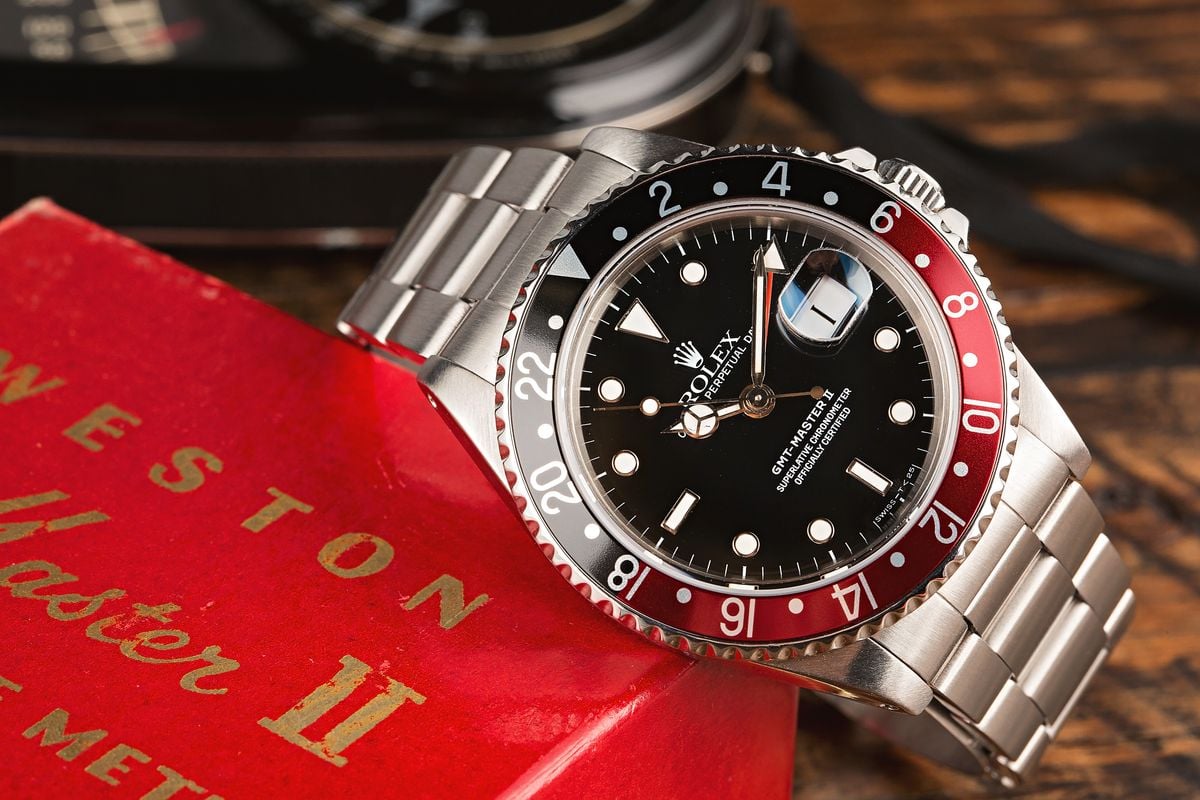
Evolution of the Rolex GMT-Master Movement
The Caliber 1036 was the first GMT-Master movement, followed shortly by caliber 1065 and 1066. In 1959, the ref. 1675 was introduced to the market, bringing with it the caliber 1565 movement. Hacking was introduced around the early 1970s with the cal. 1575, a feature that allowed the user to stop the seconds hand when the crown was pulled out to set the time.
The first significant upgrade to the GMT-Master movement came in 1981 with the release of the ref. 16750. In addition to featuring a higher frequency of 28,800bph, the caliber 3075 also included a Quickset function, a feature that allows the wearer to adjust the date mechanism independently from the time. The 1980s also marked the release of the GMT-Master II with a newly-independent GMT hand via cal. 3085. Now the wearer could adjust the dedicated local hand without disturbing the reference time, essentially allowing them to read two time zones on the dial and a third on the bezel.
The caliber 3185 followed a few years later, featuring a slimmer, more refined design, although its functions are identical to its predecessor. Until the mid-2000s, the caliber 3185 remained the sole GMT-Master II movement, when it was replaced by the caliber 3186 with a smoother hour hand and Rolex’s signature paramagnetic blue Parachrom hairspring. This movement remained in production until Rolex unveiled the current 1267xx series, complete with the brand new caliber 3285 movement.
With ten patents under its belt, the caliber 3285 is a real innovation. It features a more efficient Chronergy escapement with a skeletonized structure, resulting in a longer 70-hour power reserve. It also boasts a COSC rating in addition to Rolex’s own Superlative Chronometer certification, and it keeps the brand’s trusted blue Parachrom hairspring, making the cal. 3285 one of the smoothest and most reliable movements in the GMT-Master II collection.
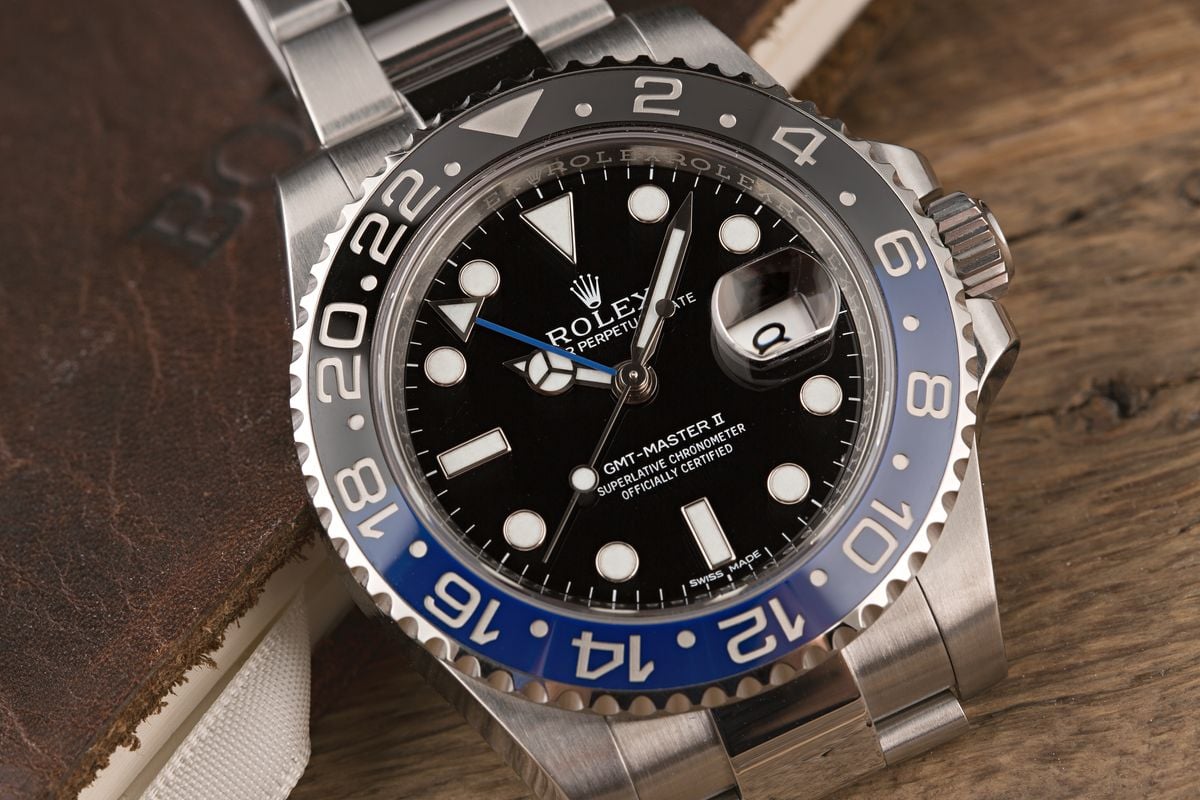
How Much is a Rolex GMT-Master?
Rolex refers to the GMT-Master as the “Cosmopolitan Watch.” It is one of the most desirable luxury watches in the world. Both in steel and precious metal, the GMT-Master makes an impressive statement on the wrist. But that doesn’t mean that it is unaffordable either. For around $10,000, you can add one to your watch box.
While the current Oystersteel edition can be incredibly difficult to purchase at retail due to high demand and low availability, there are countless options currently available on the pre-owned Rolex market for a really attractive price. If it’s a stainless steel GMT-Master II 16710 that you’ve got your eye on, you can expect to pay around $10k to $13k. Its successor, the Rolex 116710 GMT-Master II commands a slightly higher price that starts at $10k and can exceed $15k. At retail, the current ref. 126710 costs $9,700. On the secondary market, you can expect to pay anywhere between $15k and $18k.
If it’s a two-tone or solid gold GMT that you’ve got your eye on, prices for older references that start at around $12k, and top out at roughly $40k for the solid models.
Buying Pre-Owned vs. New
Whether you choose to purchase new or pre-owned, Rolex watches require a serious investment. Each timepiece is made in-house using the finest materials available. Additionally, Rolex watches almost always hold their value, so it’s no question whether they’re worth the price. If you know where to shop and what to look for, it is possible to get a good deal when investing in any Rolex.
Shopping pre-owned will almost always be a better deal. Of course, there are exceptions to this rule, such as the stainless steel GMT-Master II 126710BLRO, which currently commands significantly more than its retail price on the secondary market. However, most introductory watches are cheaper pre-owned vs. new because most watches on the retail level depreciate the second they leave the store. If you ever sell your watch, the chances of getting your money back are also much higher if you bought the watch secondhand. Depending on the Rolex, it might even appreciate in value, especially if the reference is discontinued.
On the other hand, if you purchase a Rolex brand-new directly through a retailer, there is peace of mind that the watch is authentic and won’t have any signs of wear. At Bob’s Watches, every timepiece is thoroughly inspected by a Rolex expert to ensure it’s authenticity and it is cleaned and serviced to bring it as close to like-new condition as possible. It’s also important to remember that Rolex watches are built to last. With some time and care, any pre-owned Rolex can be like-new again.
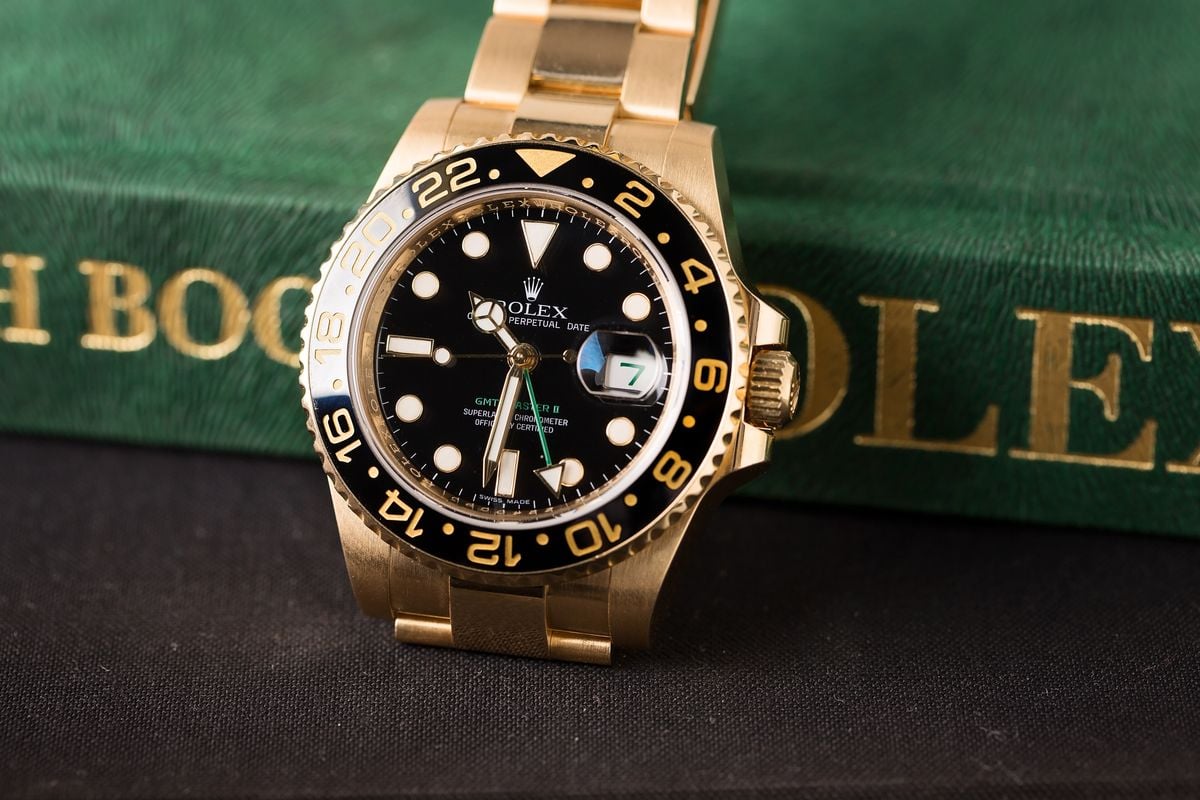
Rolex GMT-Master Features and Options
Since it hit the market in the 1950s, the Rolex GMT-Master has expanded significantly to include several bezel types, material options, and dial colors while still holding on to its original design ethos. The series is one of the most exciting watches to hunt for on the secondary market. Let’s take a closer look at its many design set options.
2 Bracelet Types:
Jubilee: Rolex first added the Jubilee bracelet to their catalog in 1945, the same year that the Datejust was released and the same year as the company’s 40th anniversary – in fact, it was actually designed specifically for the Datejsut before also appearing on other collections. It is now a fixture of many models within the brand’s portfolio. With its 5-piece links, the Jubilee bracelet is the dressier option when compared to the Oyster bracelet. The GMT-Master was the first sports watch to be offered on this iconic bracelet option.
Oyster: The Oyster bracelet is Rolex’s most common bracelet design. It is distinguished by flat, three-piece links and is more commonly associated with professional series watches. Although, today, it is also produced on some dress watches, such as the Datejust and Oyster Perpetual.
Metal Options:
Stainless steel: The GMT-Master debuted in stainless steel. Today, the metal finish is referred to by Rolex as “Oystersteel” – which belongs to the 904L stainless steel family. It is one of the most desired metal options, both for its durability and versatility.
Gold: Is there any better way to say, “I’ve made it” than by wearing a gold Rolex on your wrist? The current GMT-Master II is available in either 18k white gold or 18k rose gold (aka Everose). 18k yellow gold is available on the now-discontinued ref. 116718, as well as older-model references 16718, 16758, and 1675/8.
Two-Tone: Stainless steel and gold Rolex watches offer the luxury of gold without all the flash, and are often the more affordable option than an all-gold watch. The series is currently available in Everose Rolesor, Rolex’s term for their pairing of Oystersteel with Everose gold. However, steel and yellow gold editions are also available via references 16753, 16713, and 116713.
5 Bezel Options:
The red and blue “Pepsi” bezel is, by far, the most iconic GMT-Master bezel option. It mirrors the brand colors of the Pan Am airline for which the series was initially developed, as well as the attitude indicators on vintage airplanes. However, there are several other options to choose from that many will argue are just as iconic.
Black: All-black is one of the most versatile bezel options within the GMT series. It is not currently in production and was last produced under reference 116710LN. However, it remains a fixture of the brand and was produced on older-models, such as the references 16710, 16700, and 1675.
Coke: The Coke bezel is distinguished by a red and black insert to distinguish between day and night hours. References with this option include 16760 and 16710, and the ref. 16760 was originally only offered with the black and red coke bezel option.
Pepsi: Like the Coke bezel, the Pepsi variation features a two-tone finish to distinguish between day and night with a blue and red insert. Almost every stainless steel reference within the GMT-Master series has a Pepsi option, except for ref. 16760 and 116710. For the first time since the ref. 16710 was discontinued, the Pepsi bezel is once again in production via ref. 126710 (stainless steel) and 126719 (white gold).
Batman: In 2013, Rolex released the first black and blue Cerachom ceramic bezel affectionately nicknamed the “Batman” by the collecting community. The first reference to feature the bezel option was the ref. 116710BLNR on an Oyster bracelet, followed by 126710BLNR on a Jubilee bracelet.
Root Beer: The unique two-tone bezel initially featured a brown and gold insert. One of the most iconic references was the Clint Eastwood Rolex 16753, which made an appearance on the actor’s wrist in Firefox (along with many other films). Today, the Root Beer bezel is in production in Everose (126715) and Everose Rolesor (126711) with a black and brown ceramic bezel.
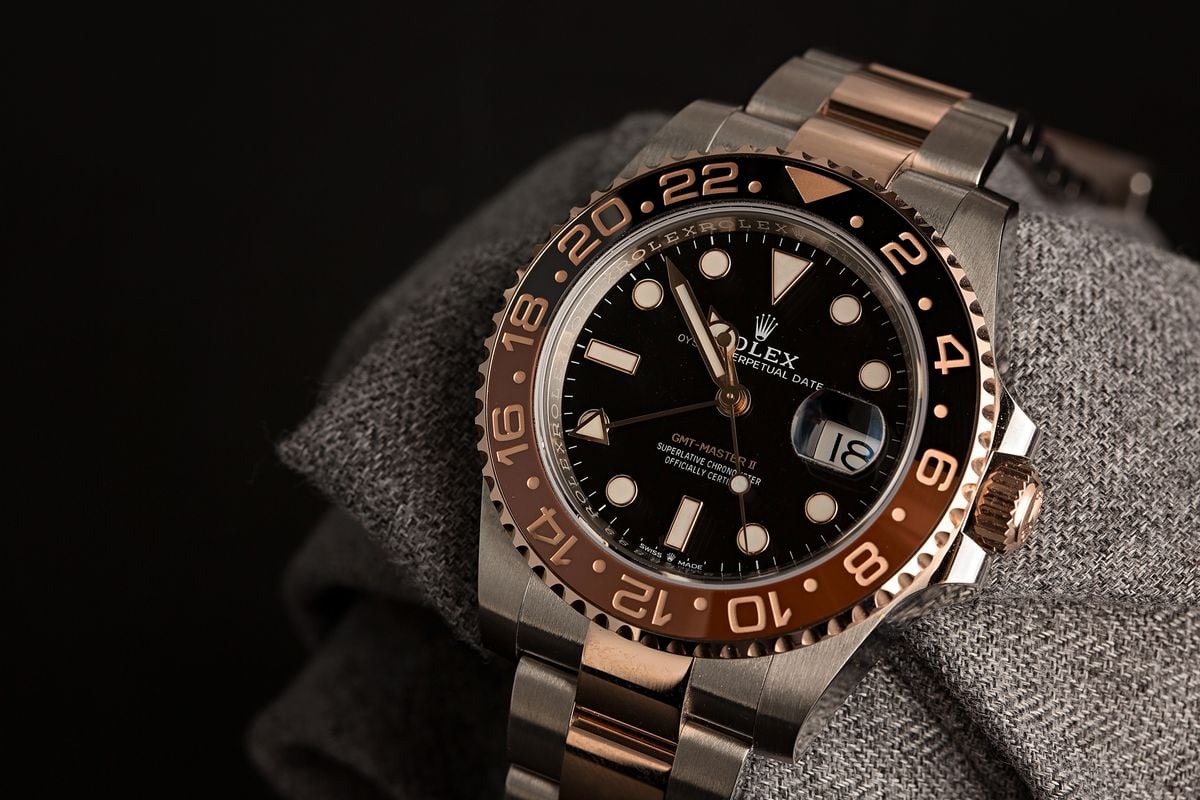
3 Bezel Materials:
Bakelite: The GMT-Master debuted with Bakelite (an early type of plastic), which was quickly replaced by aluminum.
Aluminum: Aluminum remained Rolex’s go-to bezel material for decades, until the release of Cerachrom in the mid-2000s.
Cerachrom: Cerachrom, aka ceramic, remains the only bezel material option. Compared to aluminum, Cerachrom is tougher, more lustrous, and appears more contemporary.
The Lume:
Radium: Rolex used radium lume until the 1960s when it was swapped out for tritium due to growing health concerns surrounding the radioactive material.
Tritium: Tritium remained in production until the late 1990s. Tritium is also radioactive, although not nearly as harmful, and it has about half the life of radium. As radium and tritium age, the material changes color. Many collectors refer to the varying shades of aging as patina. Tritium is distinguished on the dial as either “T Swiss T” or “T<25”.
LumiNova: LumiNova is photoluminescent rather than radioactive like radium and tritium. As a result, it is much safer for watchmakers. It also won’t fade or discolor as quickly as its predecessors. Rolex used LumiNova for only a few years from about 1998 to 2000. It is distinguished on the dial with the wording “Swiss” and these dials are sometimes referred to as modern “Swiss Only” dials.
Super-LumiNova: Super-LumiNova replaced LumiNova in 2000. It is similar in that it will not discolor or fade as quickly as tritium and is also photoluminescent. Rolex continued to use this type lume until 2008, when they switched to their own lume, Chromalight. Super-LumiNova is distinguished by the wording “Swiss Made” on its dial.
Chromalight: Chromalight is also photoluminescent. It glows blue instead of green and appears stark white during the day. Rolex claims that the blue hue is much easier to read in dim lighting, making it superior to Super-LumiNova. It also glows evenly for up to 8 continuous hours. All Rolex watches in production now feature Chromalight.
Notable Dial Variations:
Maxi Dial: The 6-digit GMT-Master II was the first instance of the Maxi dial within the series. On Maxi dials, the indices are larger, and the hands at the center are also wider to match. The generation that is in production now is topped with Chromalight lume.
“Nipple” Dial: The nipple dial is set with applied round hour markers in precious metal. Nipple dials are either black or brown depending on the watch. This dial variation was discontinued long ago and is a unique collector’s item.
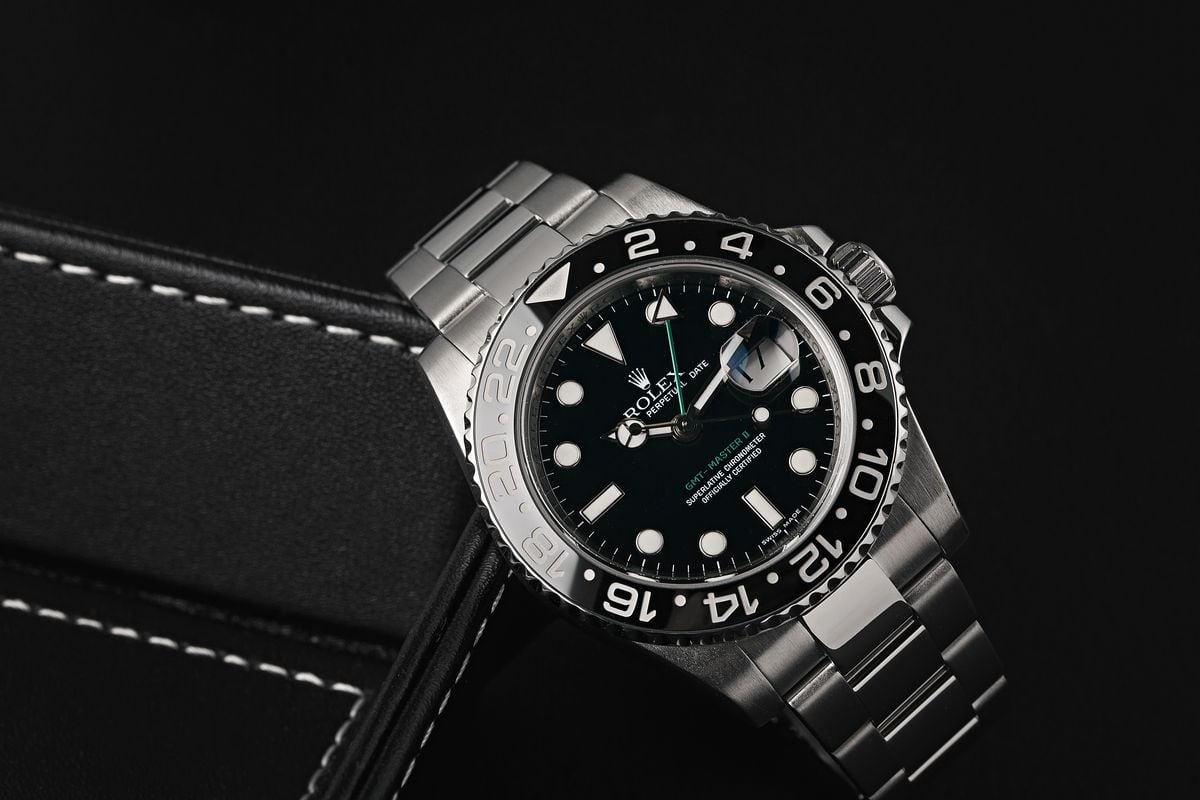
Our Favorite Rolex GMT-Master References
Now that we’ve covered the history of the Rolex GMT-Master, its features, and pricing, it’s time to review some of our favorite references and where to buy them.
Rolex GMT-Master 6542
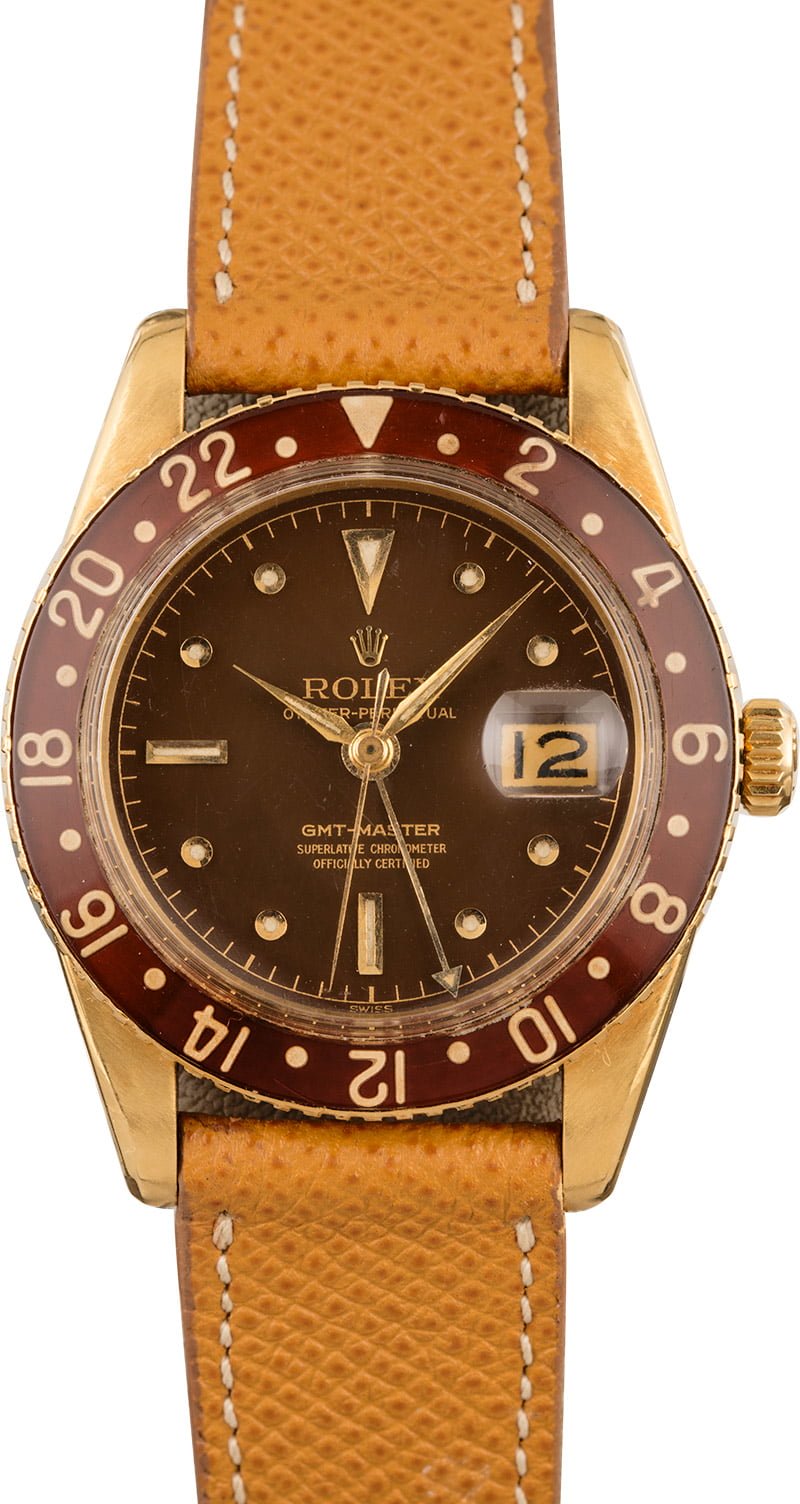
The very first GMT-Master 6542 appeared on the wrist of Pussy Galore in the James Bond film Goldfinger. Its connection with the 007 series and its place in GMT history makes the Rolex GMT-Master ref. 6542 highly collectible. It was only produced for a handful of years and is incredibly rare. Unique to this reference is a lack of crown guards and Bakelite bezel with radium graduations, which was replaced with tougher aluminum without the radium numerals. References that retain the original Bakelite bezel are among the rarest in the entire GMT-Master series and can fetch incredible sums at auction.
Rolex GMT-Master 1675
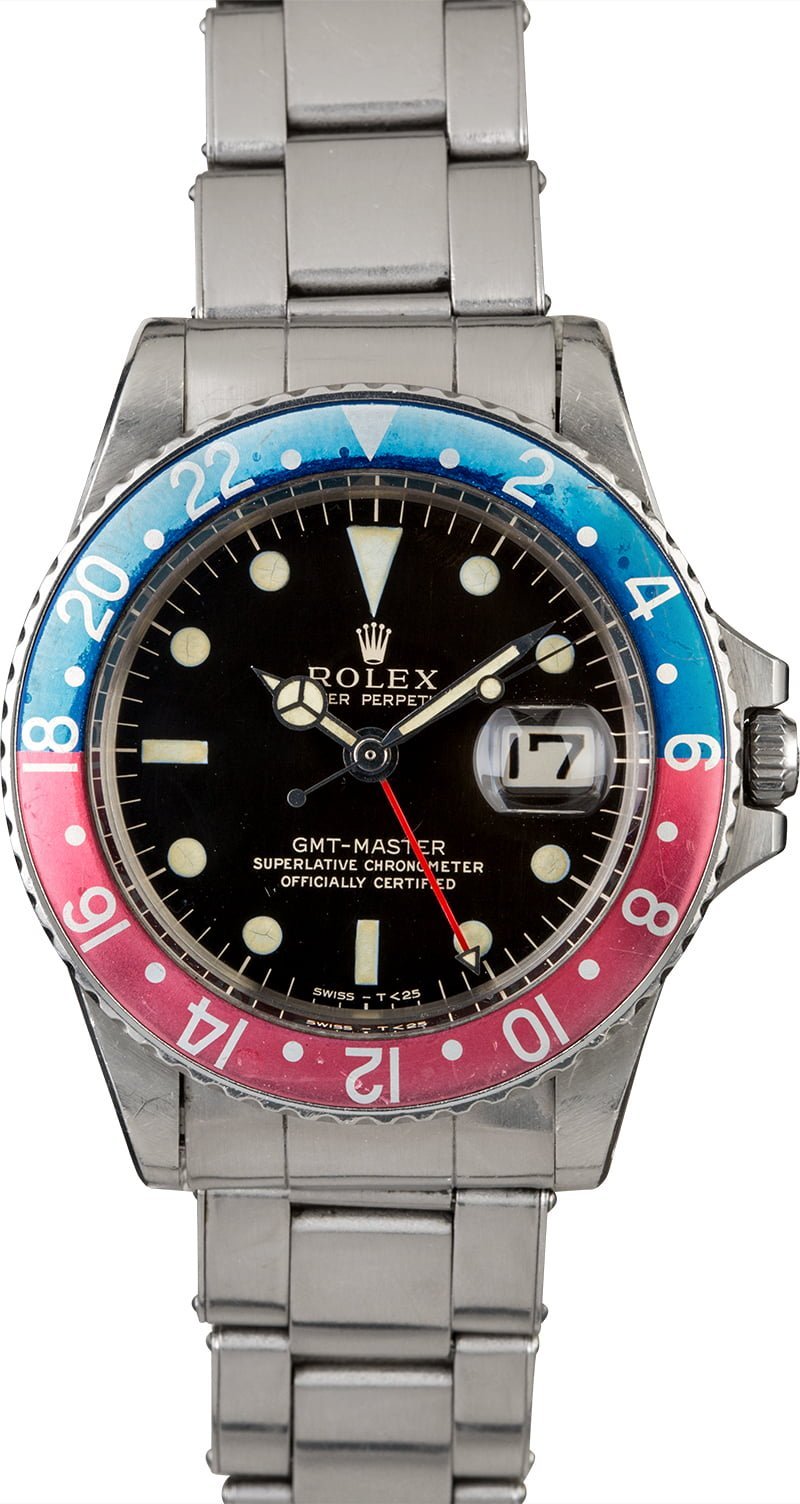
If you’re in the market for a vintage GMT-Master, the reference 1675 is worth considering. It was the first GMT-Master to include a 40mm case with crown guards. Rolex kept it in production for twenty years, making small tweaks to its design during that time. The collection is varied and consists of either glossy or matte dials, Oyster or Jubilee bracelets, three metal options, and several bezel options. During the beginning of its production, the GMT hand was topped with a small triangle. Near the end of the series, the triangle appears much larger.
Rolex GMT-Master II 16760 “Fat Lady”
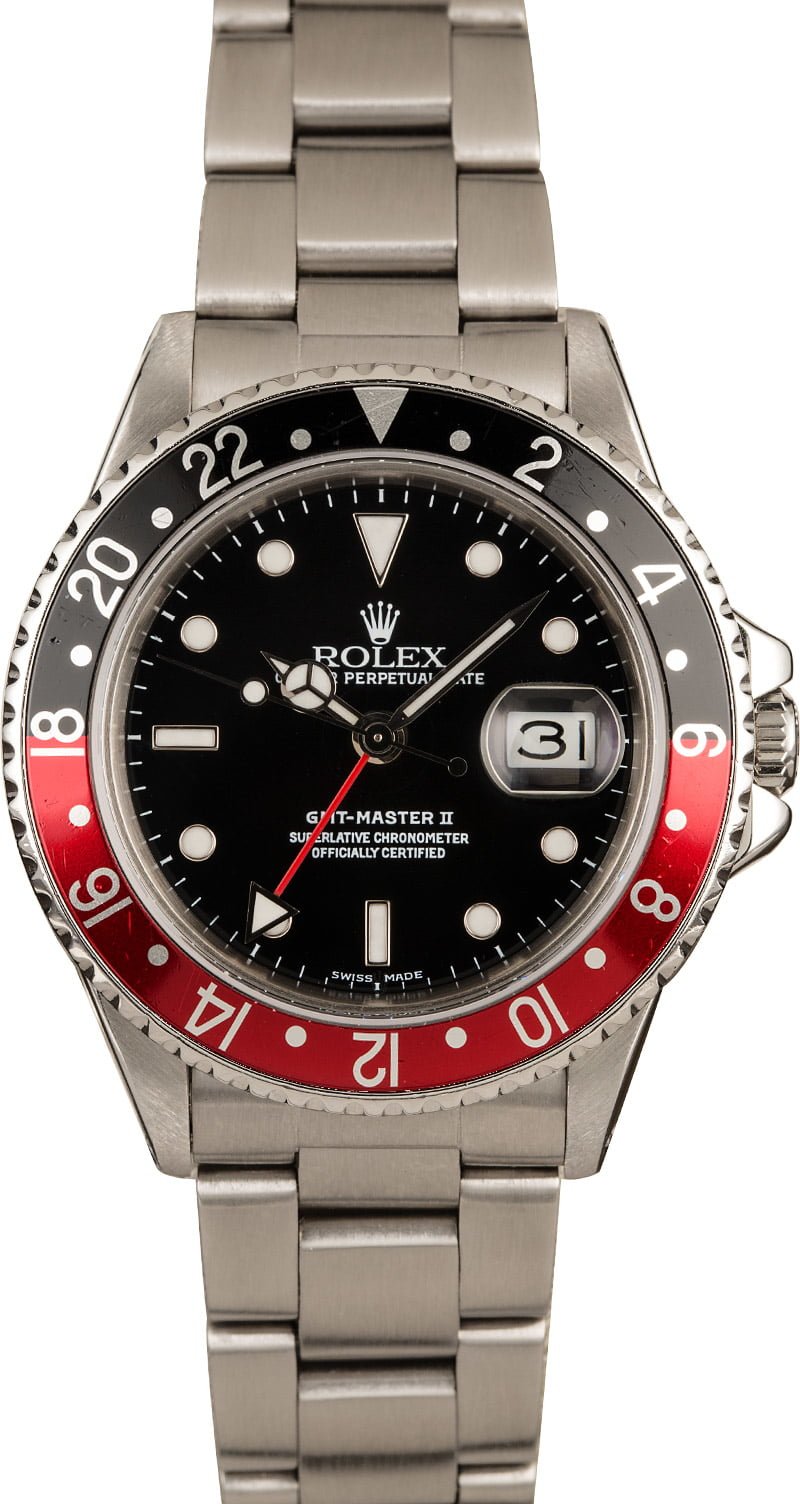
The ref. 16760 is the very first GMT-Master II. The two different hour hands were upgraded to move independently – a change that initially required a thicker case. This earned the 16760 the nickname Rolex Fat Lady collection and “Sophia Loren.” The 16760 only remained in production for about five years before it was discontinued and replaced with the slimmer ref. 16710. It was only produced in stainless steel, with the only bezel option being the red and black Coke variation. The ref. 16760 is highly collectible with an average price of just over $10k.
Rolex GMT-Master II 16710
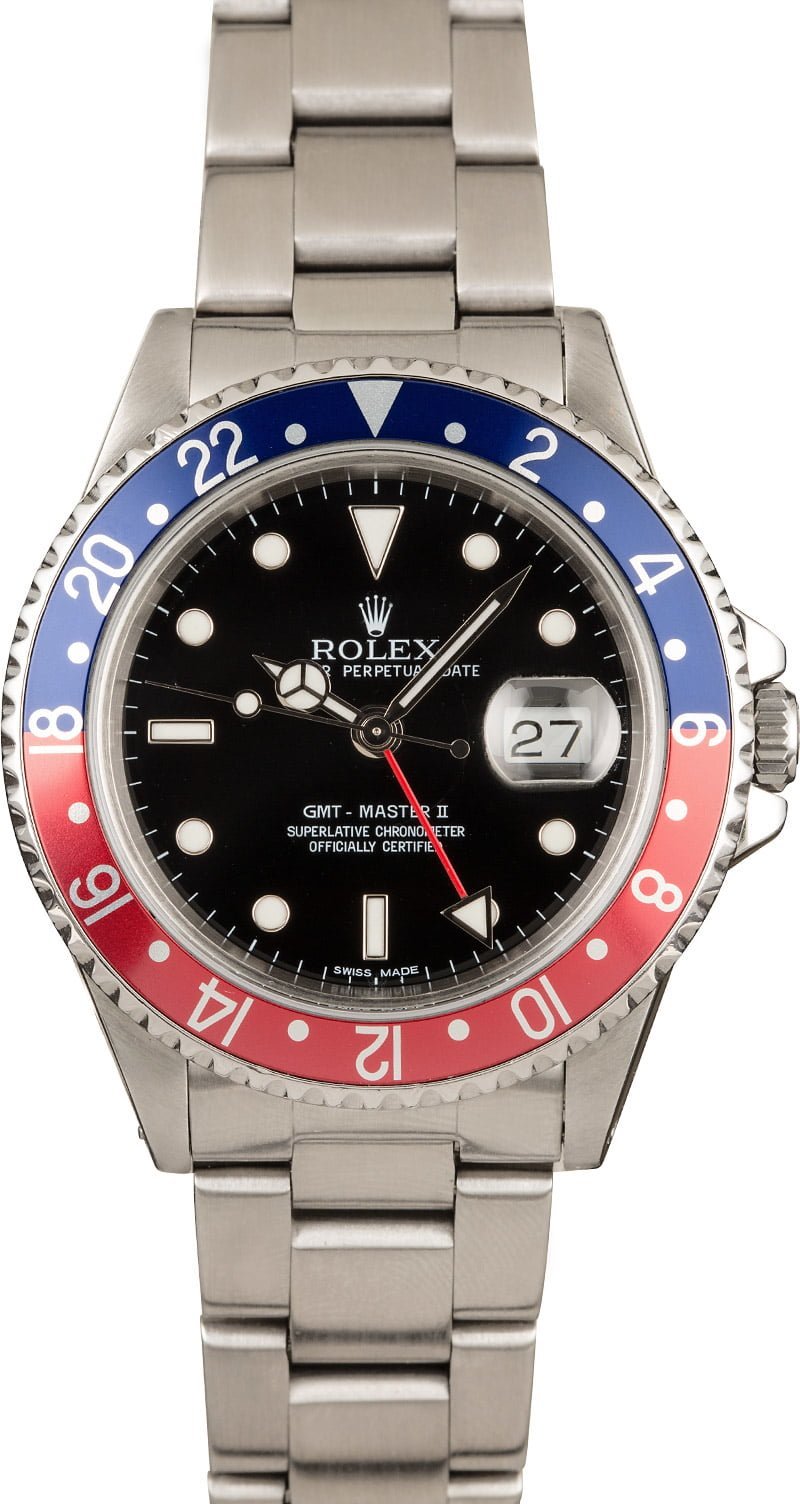
Produced from about 1989 until 2007, the 16710 Rolex is readily available on the secondary market. Many editions exist, including Coke, Pepsi, and all-black bezel inserts, Oyster and Jubilee bracelets, and tritium, LumiNova, or Super-LumiNova plots on the dial. When it hit the market, the ref. 16710 was powered by the caliber 3185 movement and then later the cal. 3186. It keeps the collection’s base 100-meter depth rating, gold-trimmed hour markers, and sapphire crystal. Depending on the year of production, the 16710 includes either holes or no holes on the lugs and either solid or hollow end links. This watch was the last before the current ceramic bezel and Maxi dial generation. You really can’t go wrong with the GMT-Master II 16710, and you can invest in one today for as low as $10k.
Rolex GMT-Master II 16713 Two-Tone
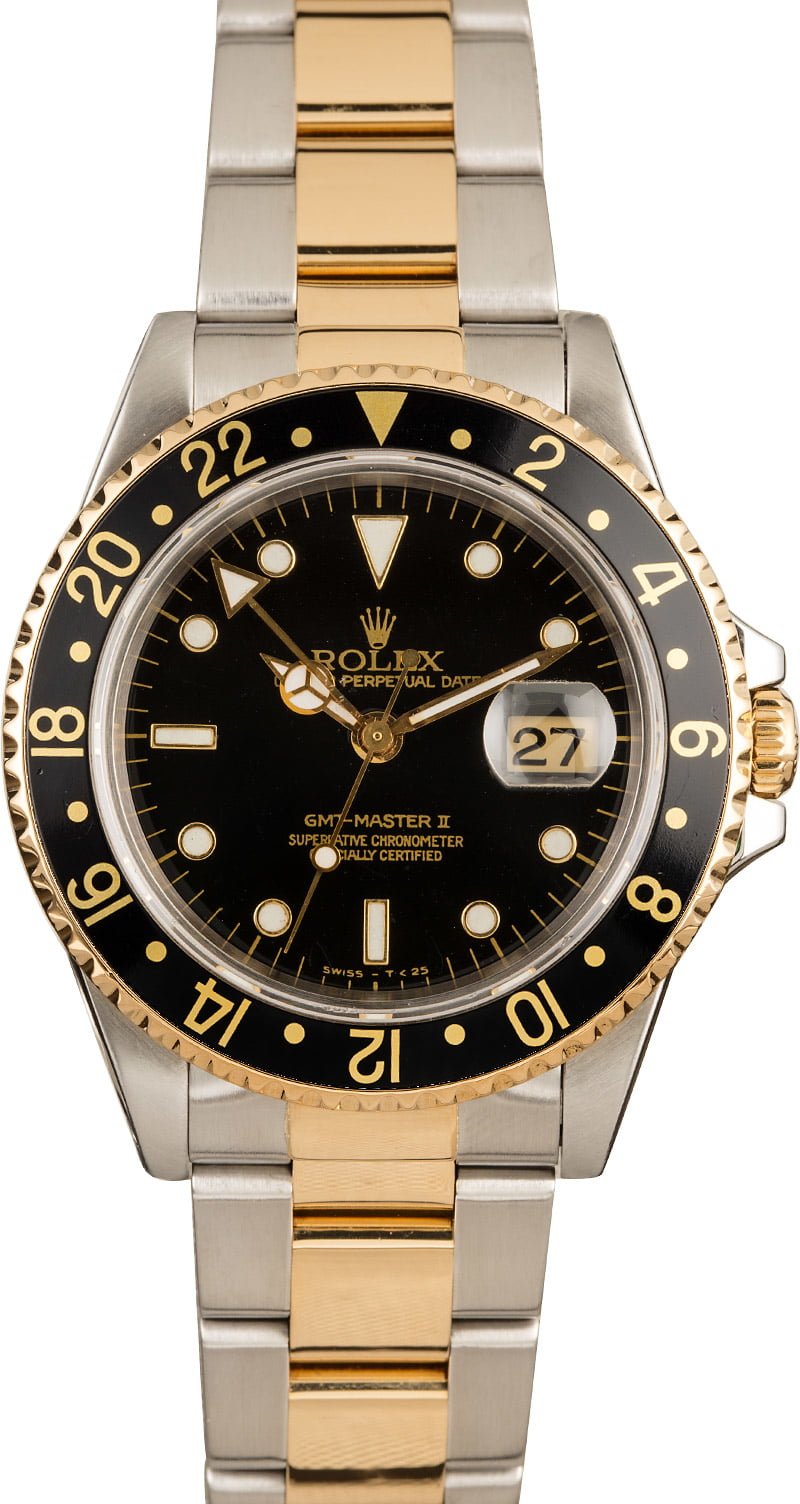
Also available within the 1671x series is the reference 16713 in two-tone stainless steel and yellow gold. This reference is available on both the Oyster and Jubilee bracelet with 18k yellow gold center links and a gold bezel mounting. Pre-owned, prices average $12k, representing only a slight premium above the stainless steel models from the same generation.
Rolex GMT-Master II 116710 (Ceramic Bezel)
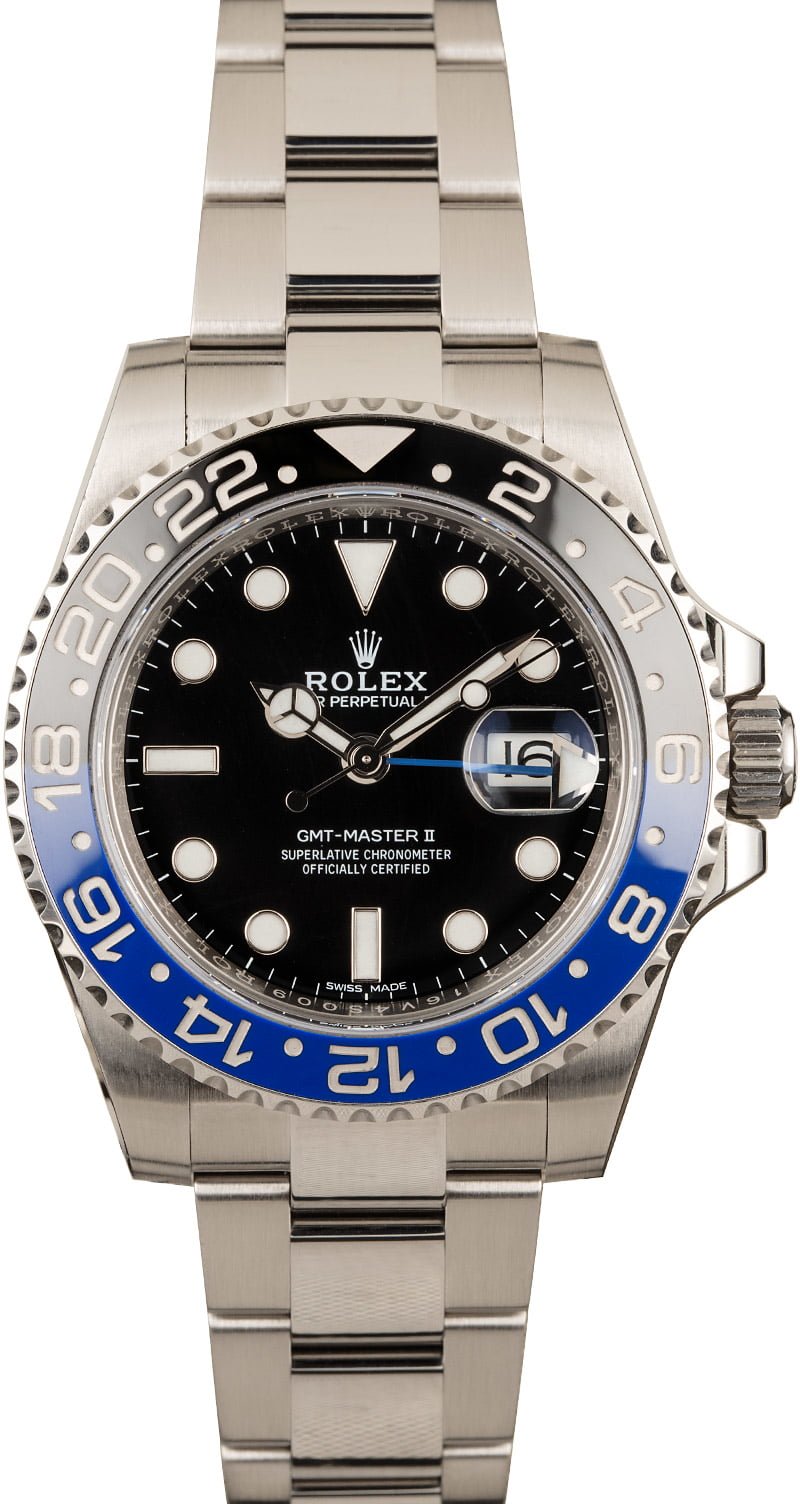
2005 marked the first instance of the 6-digit GMT-Master II in yellow gold. The aluminum bezel was traded for Cerachrom, and the hour markers on the dial grew to “Maxi” proportions. The case and bracelet changed as well, featuring a larger crown guard, a Triplock screw-down crown, an engraved rehaut, and polished center links. The GMT-Master II had entered the modern era, which would bring several exciting variations never seen within the series before. The 116710LN with a black bezel was the last instance of an all-black bezel. Currently, only two-tone bezels are in production. Black bezel editions are very popular among enthusiasts and fetch around $12k on the used Rolex market. Another popular edition of the 116710 is the Batman Rolex, which was produced under reference 116710BLNR. It was one of the first two-tone ceramic bezels ever produced by Rolex, featuring a black and blue insert and matching blue GMT hand on the dial.
Rolex GMT-Master II 126710
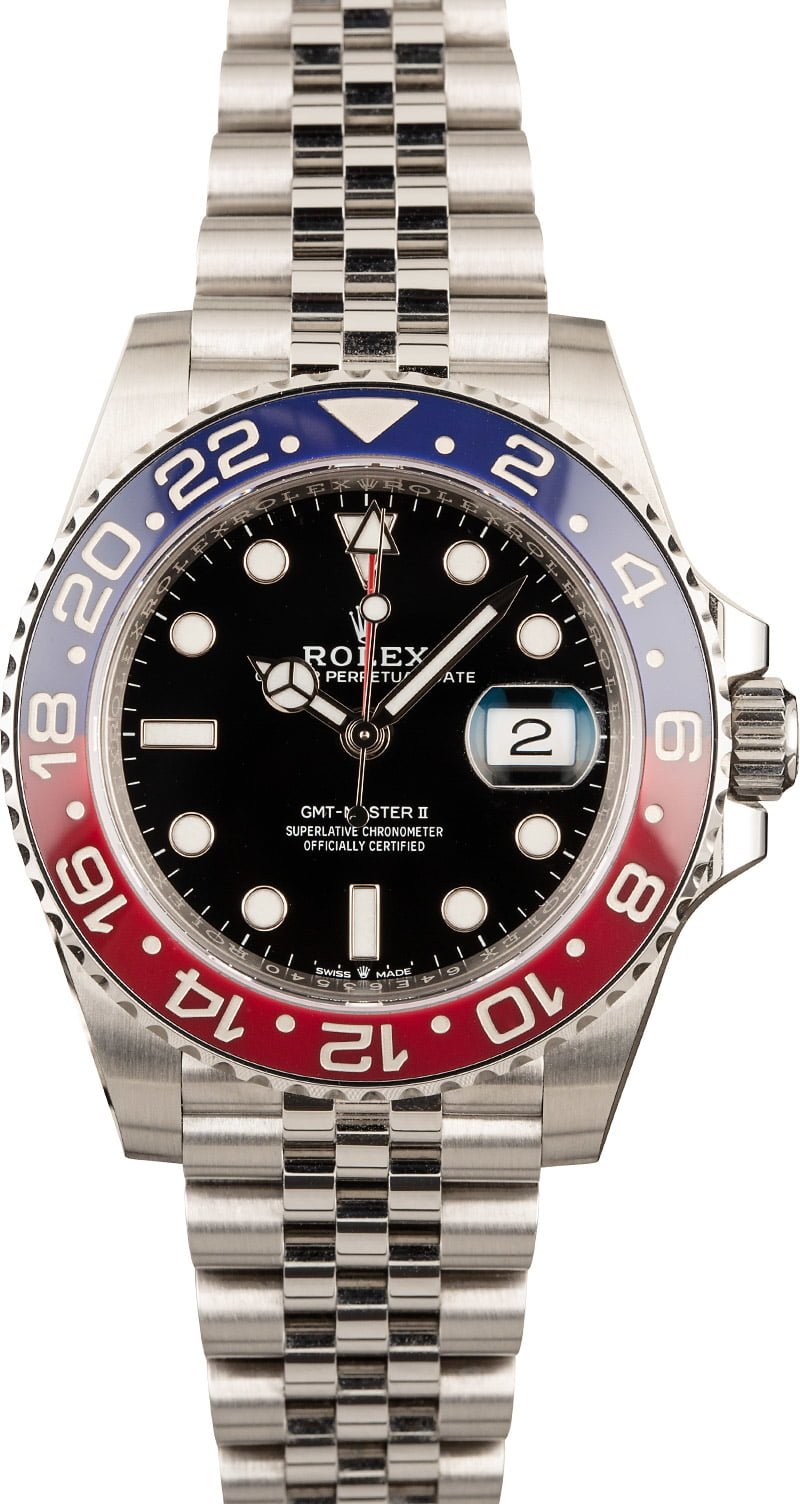
The reference 126710 is the newest edition of the stainless-steel GMT-Master II. For the first time since the ref. 16710, the Pepsi bezel is available on stainless steel via ref. 126710BLRO. Now, the Pepsi bezel is crafted from Cerachrominstead of aluminum. It also features Rolex’s staple Chromalight Maxi dial, Oystersteel, and brand-new caliber 3285 Perpetual movement. The famed pilot’s watch is now outfitted with a Jubilee bracelet with solid links and a 5mm Easylink Oysterlock clasp. As your wrist fluctuates throughout the day, the bracelet can be adjusted up to 5mm without tools. The stainless steel GMT-Master II is currently only produced on the 5-link Jubilee bracelet, and with either a red and blue Pepsi bezel (126710BLRO) or a black and blue Batman bezel (126710BLRN). Both editions retail for $9,700. Due to high demand, secondary prices average $18k.
